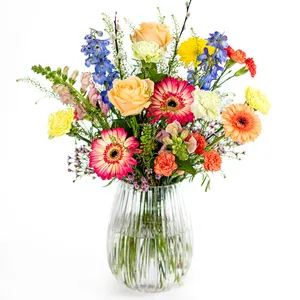Delphinium: The Towering Spires of Grace and Beauty
Delphiniums are elegant flowers known for their tall, vertical spikes of blooms in blue, purple, pink, and white. Symbolising dignity, grace, and openness, they add height and drama to floral arrangements and gardens. Valued for their vertical interest and colour contrast, they are a favourite among florists and gardeners.
COMMON NAME
Delphinium
BOTANICAL NAME
Delphinium spp.
ORIGIN
Northern hemisphere, including North America and Europe
PEOPLE ALSO CALL IT
Larkspur
FLOWERING TIME
Late spring to mid-summer
ASPECT
Full sun
SYMBOLISM
Dignity, grace, openness, positivity
Care Tips for Cut Delphinium
Trim Stems at an Angle: Cut the stems at a 45-degree angle to enhance water absorption.
Remove Lower Leaves: Remove any leaves that would be submerged in water to reduce bacteria growth.
Support the Stems: Delphiniums have long, delicate stems, so use a tall vase or floral supports to keep them upright.
Change Water Frequently: Refresh the water every two days and re-cut the stems to keep the blooms hydrated and fresh.
Avoid Direct Sunlight and Heat: Place the vase in a cool location, out of direct sunlight and away from heat sources, to prolong the life of the blooms.
Symbolism & Meaning
Delphiniums symbolise dignity, grace, and positivity. The flower’s tall, upright form is often associated with aspirations and reaching for greater heights, embodying a sense of openness and lightness. The vibrant blue varieties, in particular, are linked to tranquillity and peacefulness, while the pink and white varieties convey a gentle sense of grace and beauty. Historically, delphiniums have been used to express goodwill and encouragement, making them a thoughtful choice for gifts meant to inspire.
Frequently Asked Questions About Delphinium
Indoors: Delphinium seeds can be sown indoors 8-10 weeks before the last expected frost in your area. This generally means sowing in late winter or early spring. Sowing seeds indoors allows them to germinate in a controlled environment, providing a head start for the growing season.
Outdoors: You can also sow delphinium seeds directly outdoors in early spring after the danger of frost has passed or in late summer to early autumn, allowing them to establish before winter. For best results, plant them in a well-draining, sunny spot with rich soil.
Spring Planting: If you’re planting young delphinium plants or those started indoors, transplant them into the garden in spring, after the risk of frost has passed. This allows them to establish roots before the warmer summer months.
Autumn Planting: In milder climates, delphiniums can also be planted in autumn. Planting around that time helps the plants develop a strong root system before the winter sets in, leading to vigorous growth and blooms the following spring.
Location and Soil Requirements: Choose a location that gets full sun or partial shade, and ensure the soil is rich, well-drained, and slightly alkaline for optimal growth.
Blooming Season: Delphiniums typically bloom in early to mid-summer, usually from June to July. In some regions or with proper care, they may also produce a second bloom later in the summer or early autumn, especially if the spent flower spikes are cut back.
Bloom Duration: The flowering period lasts for several weeks, with tall spikes covered in flowers ranging from blue, purple, pink, and white, creating a stunning display in gardens.
Encouraging Re-blooming: To extend the blooming period or encourage a second bloom, it’s important to deadhead the flowers after the first blooming phase and maintain adequate watering and fertilisation.
Yes, delphinium is a toxic plant that poses risks to both humans and animals due to the presence of harmful alkaloids, particularly in its seeds and young leaves. Ingesting any part of the plant can lead to symptoms such as nausea, vomiting, abdominal pain, weakness, and in severe cases, respiratory failure or paralysis. For animals, delphinium is particularly dangerous to livestock, especially cattle, and can cause tremors, bloating, and even death. Pets like dogs and cats are also susceptible to poisoning if they consume it. While its vibrant blooms make it a popular choice for gardens and floral arrangements, it’s important to handle delphinium carefully and keep it out of reach of children and animals.


